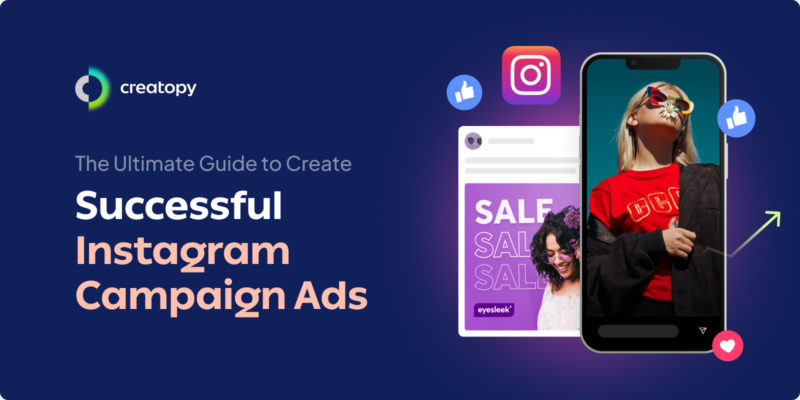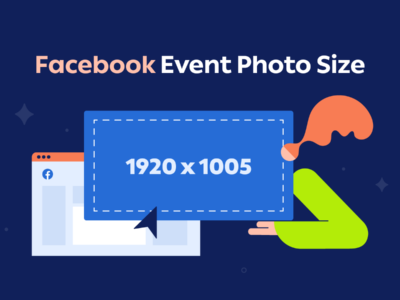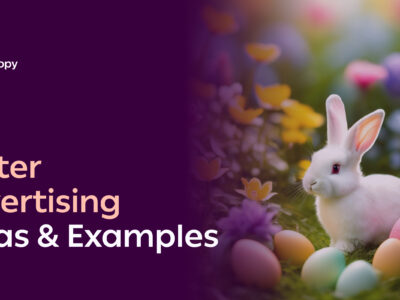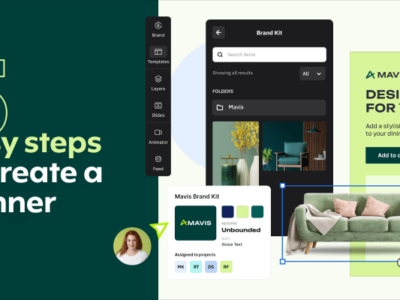Instagram campaign ads have redefined how brands connect with their target audience in 2025. With over two billion monthly active users worldwide and an algorithm that favors engaging visual content, mastering Instagram campaign ads has become essential for businesses interested in scaling their digital presence.
Instagram adverts give you precise targeting options, multiple ad formats, and integration with Facebook’s advertising system. Therefore, it doesn’t matter whether you’re launching your first campaign or optimizing existing ones: understanding Instagram’s advertising ecosystem can transform your social media marketing strategy from good to exceptional.
How to create successful Instagram campaign ads that convert?
Understanding Instagram ad formats
1. Photo ads
Single-image advertisements appear naturally in users’ feeds. They blend with regular content and generate 1-3% engagement rates when properly targeted. These ads excel at product launches, brand announcements, and lifestyle content that needs a clear presentation.
- Technical specs require a 1:1 square (1080x1080px) or 4:5 portrait (1080x1350px) format. To simplify the design process, consider using an Instagram post template that ensures the correct dimensions and layout. To maximize delivery, text must stay under 20% of the image area, and images need a minimum width of 1080px.
- For optimal performance, use strong focal points to catch attention in busy feeds. High-contrast visuals work best as users scroll, and regular testing of different image styles helps identify what’s appropriate for your audience.
2. Video ads
Videos can run up to 60 seconds and play automatically in feeds. They typically get 38% higher engagement than photo ads when optimized properly, so take a closer look at some Instagram video ads examples or use an Instagram video template to help you create video ads that convert
- You’ll need H.264 compression, square pixels, and fixed frame rates. Keep files under 4GB and use the same ratios as photo ads. Progressive scan ensures smooth playback.
- The first three seconds matter most—grab attention fast. And add captions because most people watch without sound.
3. Story ads
Full-screen vertical ads appear between organic Instagram stories for maximum visibility. To streamline the design process, consider using an Instagram story template, which ensures the correct dimensions and layout for a polished look. This format creates an immediate impact by taking up the entire screen.
- Each story card runs 15 seconds, with multiple cards linking together for longer messages. Don’t hesitate to use the 9:16 aspect ratio for the best mobile display, and keep in mind that accounts with 10k+ followers can add swipe-up links.
- As for interactive stickers, they work well for polls and questions, while countdown features help drive urgency for promotions.
4. Carousel ads
Multi-image swipeable formats let you show up to 10 cards in one ad unit. Using Instagram Carousel templates can help maintain consistency and ensure a cohesive design across all cards. Each card can have its link and call-to-action, making it perfect for telling a complete story.
- Keep image sizes consistent across all cards for a professional look. Create a natural flow between cards to enhance storytelling. Strong first cards encourage viewers to swipe through the rest.
- Use these for product catalogs, feature demonstrations, before-and-after sequences, and step-by-step guides, which work better when shown in order.
5. Collection ads
These combine cover media with product grids, creating mini-stores within the Instagram feed. This streamlines how users discover and buy products.
- Setup needs an active product catalog in Meta Commerce Manager, tagged products with current inventory, and valid merchant accounts to process purchases.
- The format includes Instant Experience features for smooth shopping, letting users find and buy products directly. This direct buying process often leads to better conversion rates than standard ads.
Read more: 21 Instagram Ad Templates You Can Grab Right Now
Setting up your first Instagram ad campaign
Here, we’ll break down the campaign setup process into manageable steps to set you up for success. Whether new to social media advertising or looking to refine your strategy, understanding these fundamental elements will help you build campaigns that deliver accurate results.
Objective selection
Before you create your first ad, we can only encourage you to take a moment to make sure that you know what success looks like for your campaign. Keep in mind that Instagram offers three main campaign objectives, and each is designed to support different business goals:
- Awareness Campaigns are perfect for introducing your brand to new audiences. They focus on getting your content to as many relevant eyes as possible, helping you build that initial brand recognition.
- Consideration Campaigns: When you want potential customers to learn more about your brand, one thing is for sure: go for such these campaigns since they are designed to encourage meaningful interactions, and this includes watching your videos, engaging with your posts, or visiting your website to explore what you offer.
- Conversion Campaigns: If you are ready to turn interest into action, conversion campaigns are built to drive specific actions that matter to your business, from newsletter sign-ups to product purchases. They use advanced tracking to reach people most likely to complete your desired action.
Budget management and optimization
Understanding Instagram’s cost structure is crucial—it’s not just about how much you spend but how effectively you spend it.
Cost structures
Instagram advertising costs vary significantly based on your industry, target audience, and campaign objectives. Here’s what you need to know about the two main pricing models:
- Cost Per Click (CPC): You’ll typically pay between $0.50 to $1.00 each time someone clicks on your ad. This model is particularly effective when you’re looking to drive specific actions, as you only pay when users actively engage with your content.
- Cost Per Mille (CPM): In this case, you’ll invest between $5.00 and $10.00 for every thousand impressions your ad receives. We recommend this model for brand awareness campaigns since it maximizes visibility among your target audience.
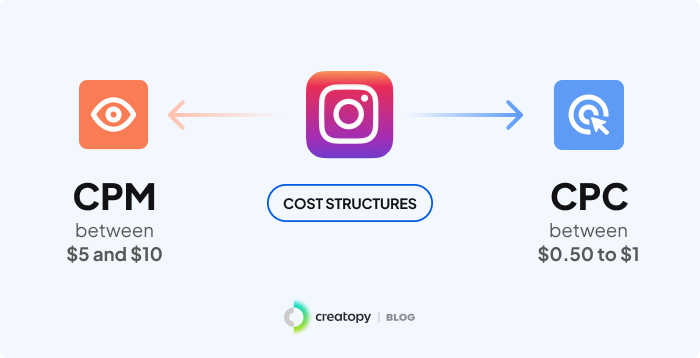
Bidding strategies
Your bidding strategy can make or break your campaign’s success. Instagram offers two main approaches to help you manage your ad spend effectively:
- Automatic Bidding: Think of this as having Instagram’s algorithm as your personal auction manager that automatically adjusts your bids to get the best possible results within your budget. This option is perfect if you prefer a more hands-off approach to campaign management.
- Manual Bidding: Want more control over your ad spend? Manual bidding lets you set specific bid amounts for each action. While it requires more attention and expertise, it can lead to better results when you understand your customer acquisition costs and target CPAs.
Advanced targeting strategies
We encourage you to think of targeting as your precision tool for reaching exactly the right people at the right time. When you nail your targeting strategy, you’ll maximize your budget and create more meaningful connections with potential customers.
Custom audience creation
The beauty of Instagram advertising lies in its ability to help you reach people who already know your brand.
- Customer List Targeting: Do you have past customers’ email lists or phone numbers? Put them to work! Upload these details to create custom audiences that help you reconnect with people who already love your brand. Plus, these audiences become goldmines for finding similar potential customers through lookalike audiences.
- Website Traffic Targeting: Ever wish you could reach out to people who’ve shown interest in your products? Track visitor behavior and create targeted campaigns for people who’ve viewed specific products or abandoned their shopping carts. It’s like giving window shoppers a friendly nudge to come back and complete their purchase.
- Instagram Engagement Targeting: Someone who’s liked your posts or visited your profile is already interested in what you offer. Why not build on that interest? Target these engaged users with content that moves them further along your marketing funnel. They’re already familiar with your brand—now’s your chance to turn that familiarity into loyalty.
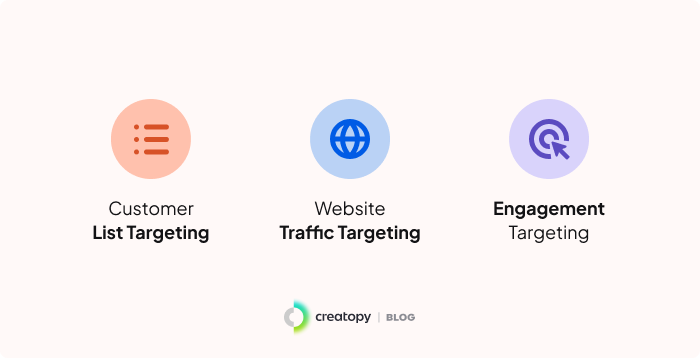
Lookalike audiences
Here’s how to expand your reach strategically:
- Audience Size Selection: Think of lookalike audiences like ripples in a pond. Start with a 1% lookalike (the closest match to your original audience) and test expanding to up to 10%. Remember, smaller percentages mean closer matches but fewer people, while larger percentages give you more reach but less precise matching.
- Multiple Seed Audiences: Create different lookalike audiences based on various customer segments—maybe one from your high-value customers, another from newsletter subscribers, and a third from recent purchasers. Testing different seed audiences helps you discover which customer profiles drive the best results.
Read more: 7 Must-Try Instagram Target Audience Practices for Strategic Success
Performance measurement and optimization
Numbers tell stories—and in digital advertising, these stories guide your path to success. Let’s break down how to measure your Instagram Ads and improve your campaign performance in ways that actually make sense.
Essential metrics
Think of these metrics as your campaign’s vital signs. Each one tells you something important about your advertising health:
- Engagement Metrics: These are your social proof indicators—likes, comments, saves, and shares. They tell you whether your content resonates with your audience. High engagement often signals content that’s worth boosting with ad spend, while low engagement might mean it’s time to refresh your creative approach.
- Click-Through Rate (CTR): This is your content’s ability to inspire action. As a reminder, a CTR between 0.5% and 1.5% is healthy for Instagram ads, but don’t get too hung up on industry averages. What matters most is improving your baseline over time.
- Conversion Rate: Here, we are at the percentage of people who take your desired action after clicking. Whether it’s making a purchase, signing up for a newsletter, or downloading a guide, this metric directly ties to your ROI.

A/B testing strategies
Success in advertising isn’t about getting it perfect the first time—it’s about continuous improvement through smart A/B testing:
- Creative Elements Testing: Think of this as your content laboratory. It’s your opportunity to test different images against each other, try various video styles, or experiment with different ad copy approaches. But remember—change only one element at a time so you know exactly what’s driving improvements.
- Audience Segmentation Testing: There is no secret that different audiences respond differently to the same content. Therefore, make sure to compare how various segments perform and use those insights to refine your targeting and messaging.
Automation and campaign management
Working smarter often beats working harder, so let’s explore how automation can help you manage campaigns more efficiently while maintaining full control over performance.
Automated rules
Think of automated rules as your always-on campaign manager, working 24/7 to keep your ads performing their best:
- Set up smart budget rules that protect your spending while maximizing results. For instance, you might want your campaigns to increase your daily budget by 15% when your cost per conversion drops below target or pause ads if they’re not performing up to par.
- Create rules that respond to performance changes in real time. Maybe you want to boost the budget on ads with CTR above 2% or pause ads if conversion costs spike above your target.
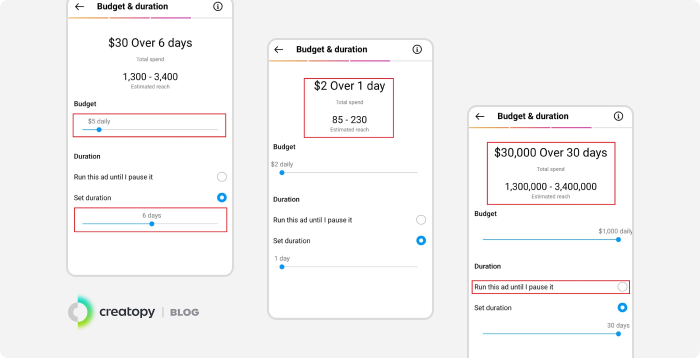
Make your campaigns calendar-smart
Success in advertising isn’t just about what you run—it’s also about when you run it:
- Sync your ad campaigns with your overall marketing calendar. When your email campaigns, social posts, and paid ads tell the same story at the same time, magic happens.
- Get ahead of market trends by planning campaigns around key business seasons. That’s not just smart—it’s essential for maximizing your ROI. Whether it’s holiday promotions, summer sales, or industry events, timing your campaigns right can significantly boost their impact.
Advanced optimization techniques
Let’s take your Instagram advertising game from good to great with some advanced strategies that move the needle.
Creative optimization
Your ad creative is like your digital storefront—it needs to stop scrollers in their tracks. Here’s how to make every pixel count:
- Visual Consistency: Brand visuals are like your business’s signature. When someone sees your content, they should instantly recognize it as yours. Think of it as building your brand’s visual signature. This isn’t just about having your logo everywhere—it’s about maintaining consistent colors, fonts, and visual style that builds trust and recognition over time.
- Ad Placement Optimization: Test different placements like a pro:
- Feed posts work wonders for showing off product details (perfect for that new collection launch)
- Stories create FoMo and drive quick actions (ideal for limited-time offers)
- The Explore tab helps you reach fresh eyes when they’re in discovery mode
Technical optimization
Even the most beautiful ad won’t perform if it doesn’t load properly. Here’s how to nail the technical details:
- Loading Speed: Slow-loading ads are like a store with a stuck front door—people will just walk away. And even if you have to optimize your image and video files, do so without sacrificing quality.
- Mobile Responsiveness: Remember: 99% of Instagram users are on mobile. Every ad element needs to look perfect on phones of all sizes—no exceptions.
Read more: Mobile Targeting: How To Reach The Right Audience On Mobile
Compliance and best practices
Let’s keep your ads running smoothly by following the rules while maximizing their effectiveness.
Ad policy compliance
Think of Instagram’s ad policies as traffic laws—they keep everyone safe and moving smoothly:
- Content Guidelines: Stay on the right side of Meta’s advertising standards for text overlay, image quality, and content restrictions. Getting your ads approved the first time saves you valuable time and maintains your campaign momentum.
- Disclosure Requirements: Transparency builds trust. When you need to label content as sponsored, do it proudly—today’s consumers appreciate honesty and are more likely to engage with brands that keep it real.
Industry best practices
Implement proven strategies for better results through systematic management of your campaigns.
- Frequency Management ensures optimal ad exposure while preventing viewer fatigue. Industry research shows that successful campaigns typically maintain a frequency of 2-3 times per user per week, balancing visibility with audience receptiveness.
- Budget Pacing requires strategic distribution across your campaign duration:
- Initial Testing Phase: Allocate 20% of your budget to test different ad variations and audience segments. This initial investment helps identify top-performing combinations before scaling.
- Performance Scaling: Direct 70% of your budget toward your best-performing ad variations. This focused approach maximizes return on proven creative and targeting combinations.
- Ongoing Optimization: Reserve 10% of your budget for continuous testing and improvement. This ensures your campaigns stay fresh and responsive to changing market conditions.
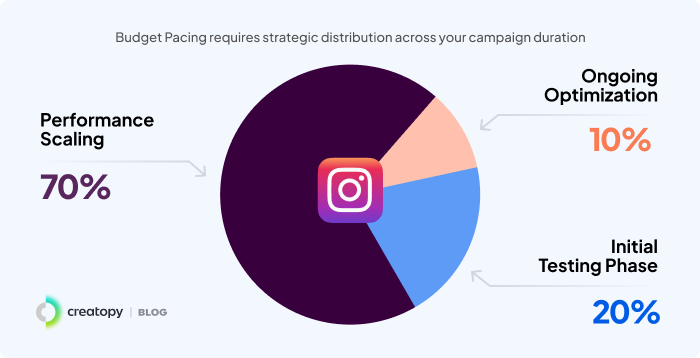
Measuring success: beyond the basic metrics
Numbers might tell stories, but you must know which numbers matter and how to read them. Here’s how to become fluent in campaign analytics:
Performance analysis
Make sure to track key performance indicators effectively through systematic measurement and comparison:
Return on Ad Spend (ROAS) Calculation involves multiple factors:
- Revenue Tracking: Monitor total spend versus generated revenue through proper conversion tracking. This metric provides a clear insight into campaign profitability.
- Customer Lifetime Value: Calculate the long-term value of acquired customers through repeat purchases and referrals. This consideration helps justify higher initial acquisition costs.
- Brand Impact Assessment: Measure indirect benefits like increased brand awareness and social proof. These factors contribute to long-term business growth beyond immediate sales.
Read more: The Importance of a Brand Strategy and How It Helps You Stay Relevant
Competitive Benchmarking provides context for your performance:
- Engagement Metrics: Yes, you must always compare your engagement rates against industry averages. This comparison helps identify areas for improvement and competitive advantages.
- Conversion Analytics: Track click-through rates and cost per result against market standards. Understanding these metrics helps optimize campaign efficiency.
- Performance Trends: Constantly monitor industry-specific metrics to stay competitive in your market. That’s how you’ll identify emerging trends and opportunities.
Remember, great Instagram campaign ads aren’t born from guesswork. Quite the opposite, they are a direct result of proven strategies and using the right tools. It might seem overwhelming initially, but cover the basics, test what works for your audience, and gradually layer in more advanced techniques as you grow.
After all, the beauty of Instagram advertising lies in its flexibility—there’s always room to optimize, experiment, and improve.
Also, keep this guide handy as your roadmap to creating Instagram ad campaigns that not only reach your audience but resonate with them and transform these insights into action with Creatopy’s advanced design platform. From automated asset creation to smart scaling features, we’ve got everything you need to make your Instagram ads stand out.
So, don’t let another campaign underperform. Start your free trial today and see the difference smart automation can make.
